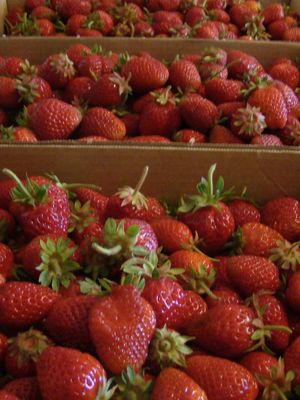Strawberries on the Bluff!
It’s that time again—strawberries are ready at some of the farms on Green Bluff in Spokane. Today was a great day for early morning picking up at Siemer’s Farm; Knapp’s and Strawberry Hill should be ripening soon.
As my husband and I were picking berries this morning, I decided I should write up my tips for successful picking. In just under 45 minutes, Ethan and I picked over 25 pounds of berries. That’s a lot of berry for little time investment (and little cash…berries were just over $1/pound!), so we must have done something right.
Here’s my process for picking berries:
-
Plan on picking after a couple of good sunny days. Sun is crucial for ripening and sweetening berries. If there have been a few gray days during picking season, wait it out. Sunshine is necessary to develop the sugars in the berries.
-
Check with the farm. Call or check their website. You want to go on a day when berries are ready. I’ve found that Green Bluff farmers are very good about updating messages and the Fresh on the Bluff page so that you know what is ripe when. We lucked out this morning, picking in a fieild on its first open day. There were berries dripping off the plants which made for quick work.
-
Get to the farm early. Strawberry season is a hot season, so picking in the cool of morning is MUCH more pleasant than a hot after noon. Get yourself a coffee on the way if you need, bring water and sunscreen for protection.
-
Bring cash. Many farms don’t take credit because the fees for a small business can be steep (this is one way they keep prices down). Prevent frustration by bringing cash with you.
-
Only pick the brightest, reddest, shiniest berries. Strawberries do not ripen any further after picking; so only choose those that look like storybook strawberries. Quickly check all sides of the berries to make sure they're ripe all the way around--if they are, they're likely bright red in the middle too. (This is also crucial information for choosing berries in the store if you’re not picking them yourself).
-
In the fields, farmers want you to pick only the ripe berries. They want you to get the best product, and they want the pickers who follow you to have ripe berries to add to their boxes later that week. If you pick under ripe berries, the ripe ones will likely rot on the plant and never be enjoyed—that’s not good for anyone.
-
Along with #5, also be careful not to pick bruised, damaged, or moldy berries. These ones will just leak all over your good berries and reduce the already limited shelf life.
-
Move the plants around (gently) as you pick. There are often ripe, delicious berries toward the middle of the plant or hidden under leaves. You don’t want to miss them.
-
Don’t dismiss the small red berries. Small berries are often the most flavorful, in fact.
-
Plan your intake wisely. You want to only pick the berries you will use within two or three days of picking. If your berries are the ripest, red-through-the-middle berries, they won’t last much beyond three days of picking. (Yes, my 25 pounds today was ambitious, but over half of them are already used or in the process of becoming jam—whew).
-
Bring a friend. The peace of the fields is wonderful in the morning, but it’s nice to have a friend in a nearby row.
- Taste a berry or two in the field. Make sure they’re sweet and juicy. Don’t eat the farm out of business, but tasting is okay—and there’s nothing quite like tasting a couple of berries in the field on a dewy morning.
Later this week, I'll post a round-up of ideas for strawberry preserves and eating. Yum!
What fresh fruit are you picking this year? What do you plan on doing with it?

